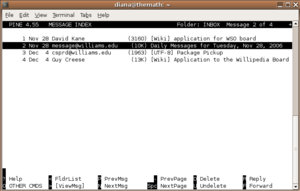PINE
PINE is a way of checking your e-mail using "command line" rather than a web browser. Highly popular, and the standard way for students to check their e-mail in the past, it has since decreased in usage and popularity. The last class to use PINE more than the web-based IMP was the Class of 2004.
Contents
How to use PINE
Windows
Go to Start | Run and type in telnet unix.williams.edu and hit Enter. Follow directions below.
Linux
Open the Terminal and type in telnet unix.williams.edu and hit Enter. Follow directions below.
All operating systems
It will prompt you for your username (07abc) and password (same as e-mail password), with Enter after each. Then it will say terpischore:unix: and you should type pine, and then Enter.
Now you will see a list of folders, and at the bottom, highlighted, it will ask you to re-enter your username (07abc, but it will actually tell you what your username is) and password. Then press I to see your inbox, and use arrows (right to see a message, left to return to inbox, up and down to scroll) and the letter commands listed at the bottom to navigate around your e-mail.
To exit pine, simply hit q and then y when it asks you if you want to quit.
Benefits
When IMP and Webmail are down, pine is usually still up. Thus, you can check your e-mail when everyone who doesn't know about pine can't.
Drawbacks
It's much harder (and 'much harder' here means pretty much impossible) to attach and view attachments using command line.
Troubleshooting
The response when I type pine is Terminal type "xterm-color", is unknown.
In Terminal, go to Preferences. Click on the Declare terminal type ($TERM) pop-up menu to change to vt100.
